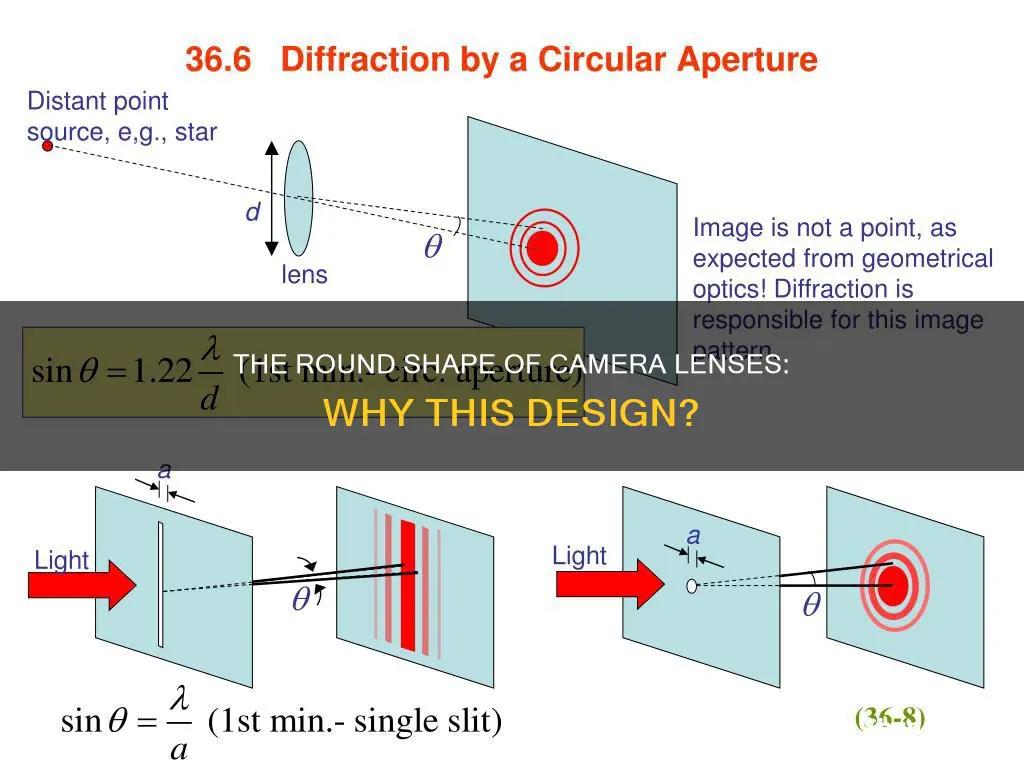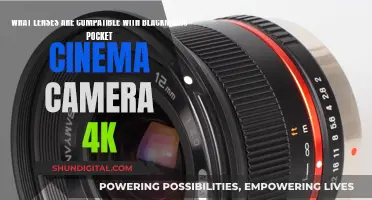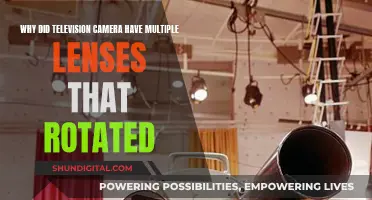
Camera lenses are round because it is easier to manufacture them in this shape. The lens elements must slide relative to each other to focus and zoom, and the easiest way to do this is with screw-style threads, which require the lenses to rotate. If lenses were square, they would need more complicated linear bearings and linear actuators to slide without rotating out of position. Round lenses are also more efficient at focusing light onto film or an image sensor, and they provide a wider perspective.
| Characteristics | Values |
|---|---|
| Easier to manufacture | Circular lenses are easier to make, cheaper, and more convenient to rotate for zoom and focus. |
| Easier to assemble | Circular lenses are easier to assemble into objectives. |
| Light absorption | Circular lenses absorb more light, which is essential for image quality. |
| Image quality | Circular lenses produce better-quality images with less distortion. |
| Shape of the aperture | The aperture is conducive to circular lenses as it gives rise to a circular space. |
| Perspective | Circular lenses provide a wider perspective for wide-angle lenses. |
| Shape of the image | The image produced by a circular lens is cropped to a rectangle by the rectangular sensor. |
| Shape of the sensor | The sensor is rectangular because it is more efficient to use rectangular film in a camera. |
What You'll Learn

Round lenses are easier to manufacture and assemble
Circular lenses are easier to manufacture and assemble into objectives. They are cheaper to make and simpler to calibrate when different lenses are combined to achieve a particular power and measure. Circular lenses are also the preferred shape for producing macro and telephoto lenses.
The circular shape of the lens is conducive to the parts of a camera such as the diaphragm and aperture. The diaphragm opens in a spiral shape, resembling a circle. The aperture also gives rise to a circular space. Therefore, a circular lens will produce the best results.
The process of manufacturing circular lenses is simpler because they are easier to move, spin and polish. It is also more convenient to rotate circular lenses for the purpose of zoom and focus. The adjustment of zoom and focus is done using rotation only. This is one of the reasons for the acceptance of the circular shape.
In addition, circular lenses have the ability to rotate without occupying any extra space. They provide a better and wider perspective for wide-angle lenses and are easier to adjust.
Understanding Camera Lenses: A Beginner's Guide to Photography
You may want to see also

Round lenses are cheaper to make and easier to calibrate
Circular lenses are easier to manufacture and assemble into objectives. They are also cheaper to make and simpler to calibrate when different lenses are combined to achieve a particular power and measure. Circular lenses are the preferred shape for producing macro and telephoto lenses.
The diaphragm and aperture of a camera are conducive to circular lenses. The opening of a diaphragm is in a spiral shape, which looks like a circle. Therefore, a circular lens will produce the best results.
Circular lenses are also able to rotate without occupying any extra space, providing a wider perspective for wide-angle lenses. They are easier to adjust and the most convenient shape to rotate for zoom and focus.
The shape of a circle is such that it minimises the maximum dimension for a particular area. The larger the optical dimension, the lower the optical quality. Thus, the light-gathering capacity of a lens is largely affected by the governed area.
Mounting 42mm Lenses: Adapting for X-Mount Cameras
You may want to see also

Round lenses are conducive to the camera's diaphragm and aperture
The diaphragm and aperture of a camera are conducive to round lenses. The aperture and diaphragm of a camera create a circular space, and a round lens will produce the best results. The diaphragm opens in a spiral shape, resembling a circle.
Round lenses are also easier to manufacture and assemble into objectives. They are cheaper to make and simpler to calibrate when different lenses are combined to achieve a particular power and measure. Circular lenses are also preferred for producing macro and telephoto lenses.
In addition to manufacturing advantages, round lenses offer a wider perspective and are easier to rotate for zoom and focus functions. They can rotate without occupying any extra space, and provide a better and wider perspective for wide-angle lenses. They are also more convenient to rotate than triangular, square, or rectangular lenses.
The circular shape of a lens also aids in capturing images of objects at varying distances. Round lenses help focus light at a single point, and the adjustment of zoom and focus is done through rotation. This is essential for capturing an image, as the image formed is inverted and must be reinverted for us to view it correctly.
The circular shape of a lens further enhances its ability to gather light, even in dim lighting conditions. This is crucial in optics to achieve the best results. Round lenses are also optimal for capturing high-resolution or sharp images. The grinding and polishing processes used in lens manufacturing ensure the desired accuracy, which is best achieved with a circular shape.
Interchangeable Lenses: Mirrorless Camera Flexibility Explored
You may want to see also

Round lenses provide a wider perspective
Round lenses are used in cameras to provide a wider perspective. The circular shape of the lens allows for better light absorption, resulting in a higher quality image. The curvature of the lens helps to focus light towards the centre, with the edges of the circle receiving less light and, therefore, producing a lower-quality image. By using a rectangular sensor, the blurred edges of the circular image are cropped out, leaving only the best part of the image.
The round shape of the lens also makes it easier to manufacture and assemble. The process of grinding and polishing the lens is simpler for a circular lens, and the circular shape is also conducive to the rotation required for zoom and focus. Additionally, the diaphragm and aperture of the camera create a circular space, which works best with a circular lens.
The use of round lenses in cameras is a combination of scientific and practical reasons. The circular shape provides a wider perspective and better light absorption, resulting in improved image quality. At the same time, the round lenses are easier to manufacture, assemble, and rotate for zoom and focus functions.
Camera Contact Lenses: Fact or Fiction?
You may want to see also

Round lenses are easier to rotate for zoom and focus
Circular lenses are the easiest to rotate for zoom and focus. Rotating a triangular, square or rectangular lens is very difficult. It is more convenient to rotate circular lenses for the purpose of zoom and focus. The adjustment of zoom and focus is done using rotation only. This is one of the reasons for the acceptance of the circular shape.
The lens elements must slide relative to each other to focus and zoom. The easiest way to do this is with screw-style threads, which require the lenses to rotate. If we used square lenses, they'd need more complicated linear bearings and linear actuators to slide without rotating out of position.
The lens must be able to rotate without occupying any extra space. Spherical lenses provide a better and wider perspective for wide-angle lenses. They are easier to adjust.
Understanding Camera Lenses: Capturing Unique Perspectives
You may want to see also
Frequently asked questions
Camera lenses are round because it is easier to manufacture them into a spherical shape. Round lenses are also easier to calibrate when different lenses are combined to achieve a particular power and measure. Circular lenses are also easier to rotate for zoom and focus.
The image sensor is rectangular because it is more efficient to use rectangular film in a camera than a series of ovals or some other shape. The rectangular shape also leads to better pictures.
Rectangular photographs are more intuitive and pleasing to view. They are also much easier to print and display on walls, which are usually rectangular or square.







